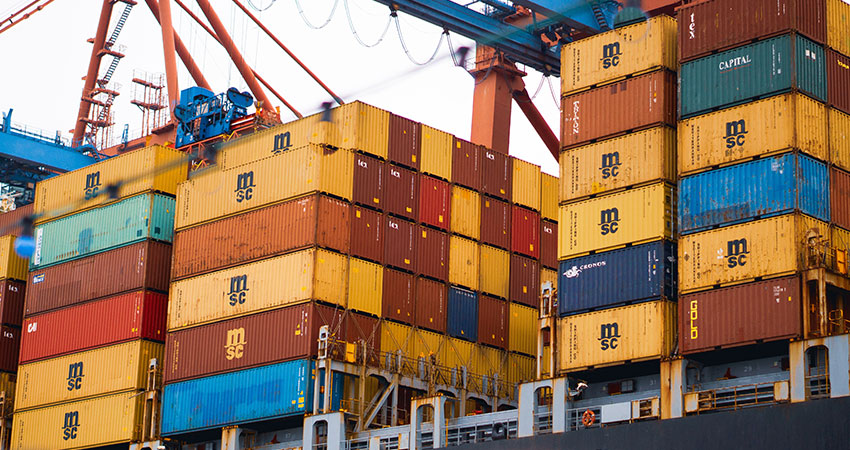Photo credit: Eilis Garvey on Unsplash
Remember the ZIM Kingston freighter debacle last fall? There’ve been so many disruptions in the past two years, it mostly was forgotten after the flames were put out, and you’d be forgiven for forgetting.
The ship lost 109 containers overboard after an intense storm off the coast of Vancouver in October. A day later, a fire broke out and burned aboard the ship for more than a week before authorities were able to douse the flames. The ship sat anchored for weeks, much of its cargo rotted, ruined or in ashes while waiting for approval to dock and begin wading through the mess.
I had several shipper friends with freight on that ship. They had to go to their bosses every day and answer questions like: Was our cargo on that ship? Was it lost overboard or burned? Is it recoverable? What’s the value of product we had on the ship? Do we have the same SKUs on any other ships?
Very few freight forwarders could answer those questions for their customers, meaning those shippers didn’t have answers for their bosses. The forwarders that did have answers won customers for life.
ZIM Kingston is an extreme example. But it is every day that a shipment is delivered late and misses a sailing. It is every day that a ship is full and cargo gets rolled. The forwarders who are able to arm their customers with detailed answers to what will be late (down to the SKU, style, color, etc.) will keep that business forever, often even if they aren’t the lowest price provider.
When you can be a strategic partner in a crisis, big or small, you earn true loyalty that can’t be bought.
The New Normal Brings New Bedfellows
Between COVID disruptions, port backlogs, labor shortages, border controls and bottlenecks all along the supply chain, freight forwarders and shippers have felt the strain of a turbulent two years.
One little-discussed but significant trend: There have been lots of new relationships formed that otherwise wouldn’t have existed. Retailers and CPG shippers need cargo space wherever they can find it, and their usual forwarders can’t always accommodate them. For forwarders, this means they’ve been having lots of first dates — a dynamic that can’t and won’t continue forever.
When things settle down (and they eventually will!) shippers will again cut the number of forwarders they work with to a more manageable level. They won’t be forced to give business to anyone who can find cargo space, because space will be more available.
So, they’ll trim up based on price, sure, but more often they will decide based on service. Shippers will be asking themselves questions like: “Who was really there for me when things were hard? Who gave me excellent service when my stuff was rolled three voyages in a row? Who had answers when I had questions about where my cargo was and when it would be arriving?”
One question they likely won’t ask: “Who has the best tech?”
As much as it kills me to say this as a tech CEO with lots of freight forwarder friends and customers, shippers don’t care about your APIs and EDIs. Everyone has tech that’s functionally good enough. What really counts is how you use tech to deliver great service.
Much like the ZIM Kingston saga: The forwarders who excelled as partners will be well positioned to turn these recent first dates with shippers into long, beautiful relationships. They have been using tech to create efficiencies that allow them to devote time and attention to stellar customer service over the past two years when business was tough.
I want to be crystal clear. Operationally, this lack of visibility and customer service isn’t freight forwarders’ fault. They are so overwhelmed by the ongoing turmoil that they simply don’t have the minutes in the day to go the extra mile.
The Supply Chain Crisis on the Ground
Here is the dirty little secret of the supply chain crisis: We see dramatic images of long lines of cargo ships at the Port of Los Angeles, trucker strikes in Europe and empty shelves at Walmart. But what does the supply chain crisis actually look like on the ground for most freight forwarders and shippers?
Emails. So. Many. Emails.
In 2018, if I needed to move goods from Shanghai to Los Angeles, it was a relatively simple proposition. In 2021, that same single shipment might require 50 emails instead of two (looking for space, carrier negotiations, tracking down what got rolled and when it will go out, figuring out what got moved, etc.). When something goes wrong, whether it’s a disaster or a minor delay, there is simply no time to provide that extra level of service, no matter how much forwarders wish they could.
Implementing process automation and cargo visibility tools obviously could have allowed freight forwarders managing the ZIM Kingston incident(s) to be more focused on customer service and offer regular, multiple updates daily to customers. Instead, most time was consumed by circulating emails trying to find answers, calling overseas agents and constantly refreshing ZIM’s website hoping for updates. That obviously saps the ability to provide good customer service.
Automation Creates Capacity, Better Customer Service
Here’s where tech comes in. The argument for automation has always been cost savings. My argument is that automation and integration is most useful when it creates capacity to do amazing customer service. Your tech doesn’t provide the service. And it shouldn’t. Let the tech do the dirty work so your team can do the service.
Shippers are keeping close watch on those handling their freight right now. They’ll do what it takes to get through the current crunch, but once the upheaval settles, they’ll be quick to line up behind those that supported them and had their back, rather than those they had to chase for updates in a stressful situation.
Use your tech to wow those shippers. When the first date is amazing, you might just get to go steady.
Brian Glick is founder and CEO of Chain.io

